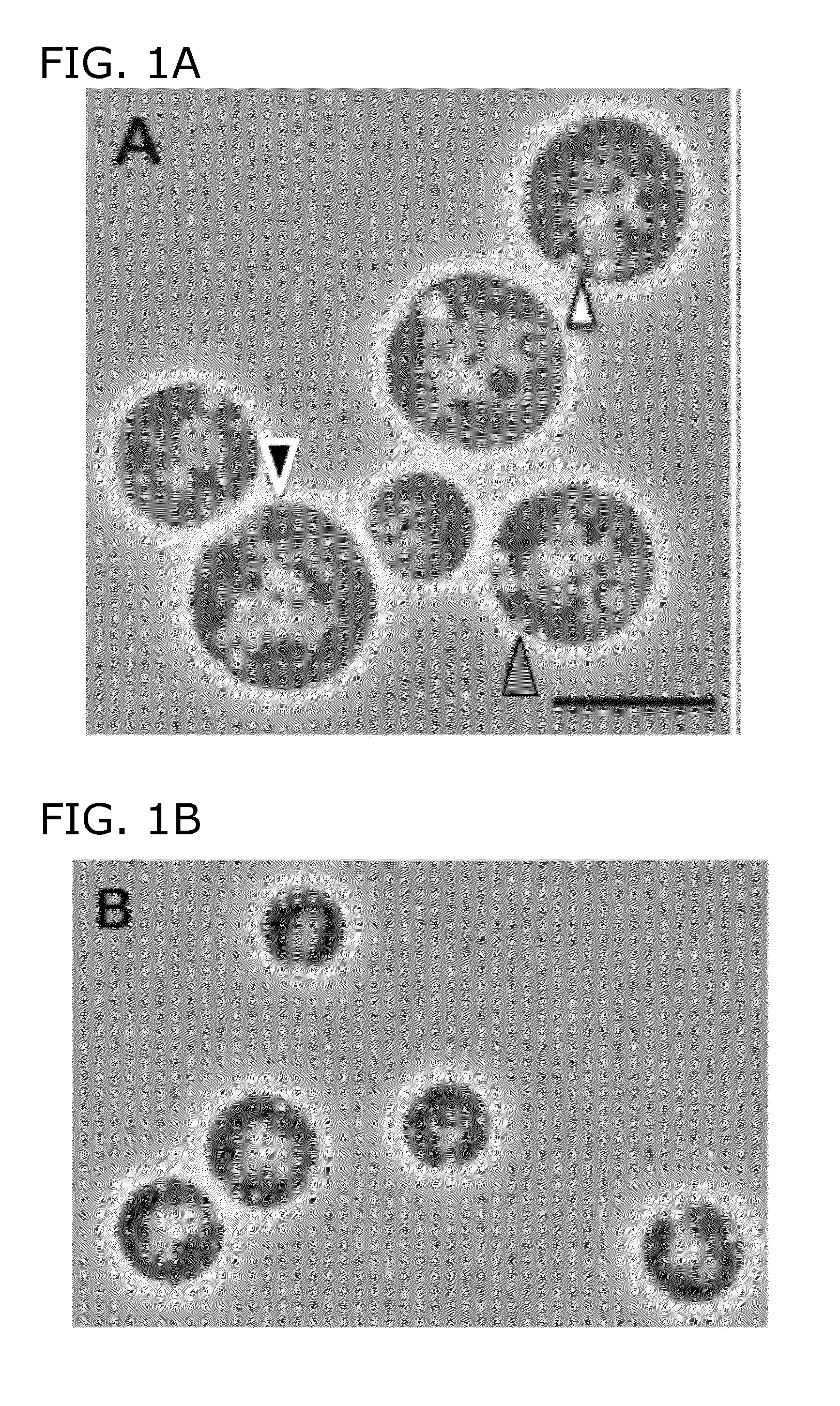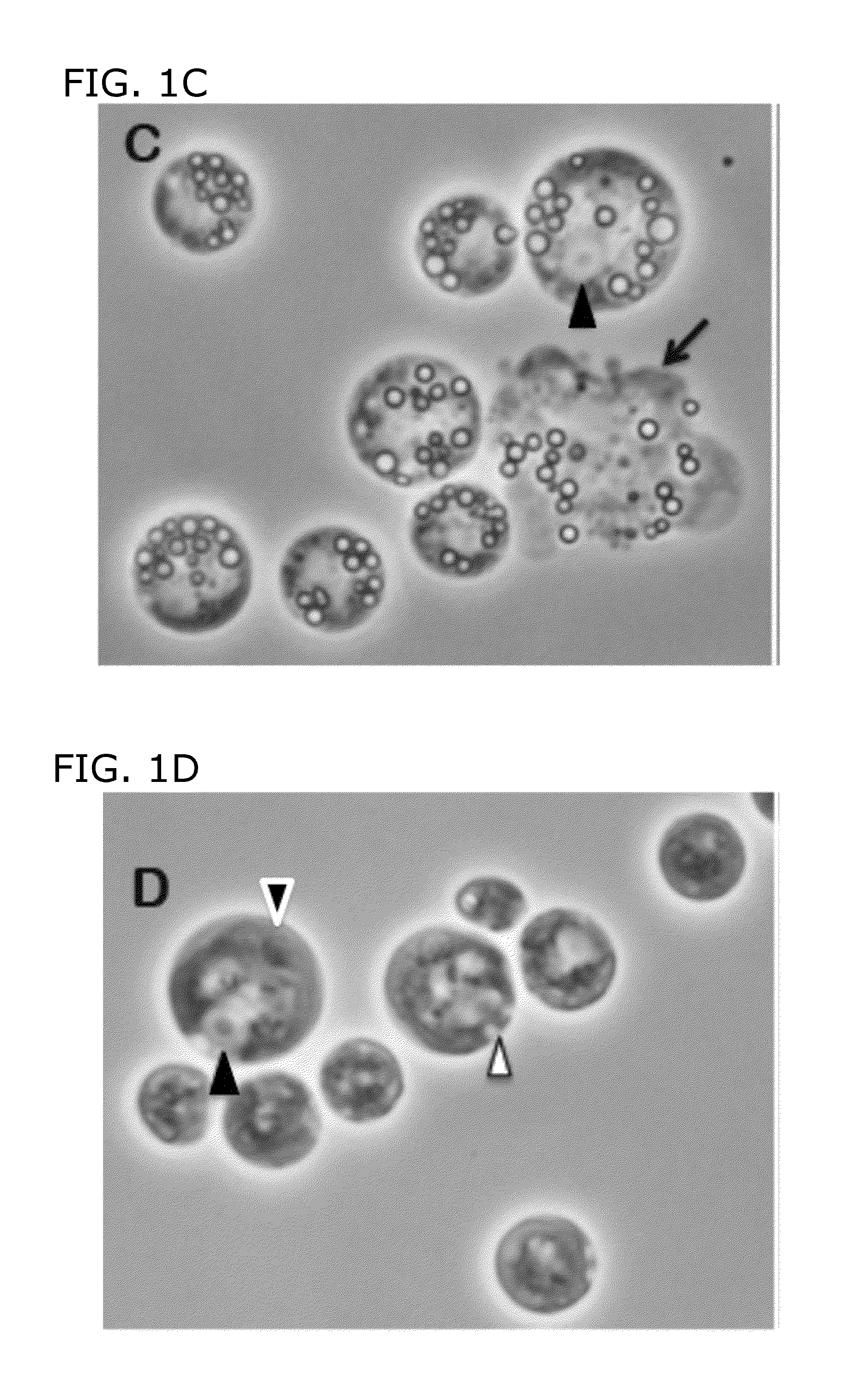Buoyant triacylglycerol-filled green algae and methods therefor
a technology of triacylglycerol and green algae, applied in the field of buoyant triacylglycerol-filled green algae and methods therefor, to achieve the effect of convenient harvesting
- Summary
- Abstract
- Description
- Claims
- Application Information
AI Technical Summary
Benefits of technology
Problems solved by technology
Method used
Image
Examples
example 1
[0096]This example illustrates the analysis of LB formation in C. reinhardtii using phase contrast and bright-field light microscopy of living cells and deep-etch electron microscopy (DEEM) of quick-frozen living cells.
[0097]FIGS. 1-5 present montages of living STA6 and sta6 cells visualized by phase contrast and bright-field (FIG. 4) microscopy, all photographed and printed at the same magnification. The immotile cells settle onto the glass slide without fixation and they flatten out as they dry, permitting high-resolution images. Eventually they “pop” when the plasma membrane lyses (Wang, Z. T., et al, Eukaryot Cell 9; 1856-68, 2009), depositing their starch and LBs (STA6) or their LBs (sta6) in situ on the slide. The two contractile vacuoles continue to pump until a cell pops, indicating that the cells are still operant during the drying process.
example 2
[0098]This example illustrates nitrogen, starvation of cells for two days from log phase.
[0099]FIG. 1A shows sta6 cells in mid-log phase (2-3×106 cells / ml); FIG. 1B shows sta6 after 1 day of N-starvation from log-phase in HSM+20 mM acetate; and FIG. 1C show sta6 cells after 2 days N-starvation. In these experiments, the cultures increase in cell number after transfer to N-free medium, stabilizing at 0.8-1×107. As used herein, “transfer to N-free medium” means that cells are transferred to a medium lacking a nitrogen source; however, this does not exclude the possibility that a small, residual amount of nitrogen source (e.g., NH4Cl from a previous medium remains in the medium with, the cells, FIG. 1D shows STA6 in log-phase; FIG. 1E shows STA6 cells that were N starved, for 2 days; and FIG. 1F shows sta6 cells complemented with a STA6 transgene. Black arrowheads point out nuclei with central nucleoli; white arrowhead point out contractile vacuole(s); Gray arrowhead outlined in black ...
example 4
[0104]This example illustrates N-starving cells in the light without acetate.
[0105]FIG. 2C shows sta6 cells (hat were N-starved in the light for 2 days without acetate. FIG. 2C shows sta6 cells that were N starved in the light for 2 days without acetate. The omission of acetate prevents the accumulation of any visible LBs in both the sta6 strain and the STA6 strain, although there is no inhibitory effect on starch accumulation (Martin, N. C., and U. W. Goodenough, J. Cell Biol. 67:587-605, 1975). When the acetate-free cells are provided with 20 mM acetate after 2 days, they engage in robust LB formation during the following 2 days.
PUM
| Property | Measurement | Unit |
|---|---|---|
| concentration | aaaaa | aaaaa |
| volume | aaaaa | aaaaa |
| temperature | aaaaa | aaaaa |
Abstract
Description
Claims
Application Information
 Login to View More
Login to View More - R&D
- Intellectual Property
- Life Sciences
- Materials
- Tech Scout
- Unparalleled Data Quality
- Higher Quality Content
- 60% Fewer Hallucinations
Browse by: Latest US Patents, China's latest patents, Technical Efficacy Thesaurus, Application Domain, Technology Topic, Popular Technical Reports.
© 2025 PatSnap. All rights reserved.Legal|Privacy policy|Modern Slavery Act Transparency Statement|Sitemap|About US| Contact US: help@patsnap.com



